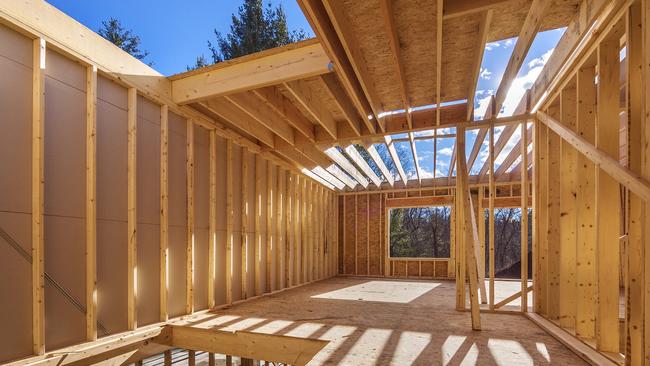Post-boom towns falling behind on mortgage repayments
Signs of rising mortgage stress have emerged as the rate of missed home loan payments hits a five-year high.

Signs of rising mortgage stress have emerged as the rate of missed home loan payments across Australia hits a five-year high and more than $26 billion worth of mortgages have fallen behind.
Even with the official cash rate sitting at a record low, mortgage delinquencies hit record highs in the mining downturn hit states of Western Australia, Northern Territory and South Australia, where unemployment is squeezing more borrowers, according to figures tracked by Moody’s.
The apartment hot spots of Sydney, Melbourne and Brisbane have relatively low rates of late mortgage payments, showing buyers are largely on top of loans.
Moody’s vice-president Alena Chen said the proportion of overdue loans was set to increase over the rest of the year, particularly as underemployment — where workers can’t get as many hours as they would like — continued to drive loan delinquencies higher.
The share of mortgages more than 30 days overdue rose to 1.62 per cent in May, up sharply from 1.5 per cent a year earlier and the highest rate since 2012.
“Higher delinquencies raise the risk of mortgage defaults and are therefore credit-negative for Australian residential mortgage-backed securities,” Ms Chen said.
Since taking over as governor of the Reserve Bank a year ago, Philip Lowe has warned the era of low interest rates and manageable mortgage repayments will not be a permanent feature of the financial system. Analysts are concerned rising interest rates will push many financially vulnerable households further into mortgage stress.
Moody’s said Western Australia, with a rate of 2.96 per cent, bore the brunt of the rising mortgage delinquencies, driven by a weak economy and falling house prices. Underemployment hit 10.4 per cent in Western Australia in May, well above the national average of 8.8 per cent. House prices in Perth fell 2.1 per cent over the year to July and have fallen for more than two years. More than 7 per cent of home loans in the West Australian outback were overdue in May.
The share of Northern Territory borrowers more than a month overdue was 2.8 per cent, compared to a 2.3 per cent rate in South Australia. Both are record highs. Darwin house prices have fallen 6.4 per cent over the year. South Australia has the worst jobless rate in the country, at 6.8 per cent.
Martin Barrett, chief executive of Bundaberg-based Auswide Bank, which has the majority of its $3 billion loan book concentrated in central and southeast Queensland, said the situation was improving, contrary to the outlook of Moody’s.
“Overall I would say we’ve seen less stress, particularly in the course of the last 12 months, than we’ve seen in the few years preceding. It actually seems to be improving,” Mr Barrett told The Australian.
“Across regional Queensland and areas that are mining-related, we’ve seen a few challenges where property prices have been falling. Those decreases have been more pronounced the more reliant those towns are on mining. But in the last 12 months, those towns seem to have stabilised,” he said.
Auswide has about $20 million worth of overdue mortgages on its books, slightly more than the $17.4m worth at the start of the year. Still, it’s well below the mid-2014 figure of $43m.
Mr Barrett said many investors in country towns were often borrowers from large cities who had been approached to invest by property spruikers. He said smaller regional lenders were more insulated as their credit teams were more familiar with country towns than their major bank rivals.
The threat of rising arrears is absent in Sydney and Melbourne, where most of the country’s housing stock sits. Delinquencies in both cities fell over the year, despite house prices continuing to gallop higher. Sydney homes are 12 per cent more expensive compared to a year ago and Melbourne prices are up 16 per cent.
“Rising house prices have supported mortgage performance in these states, giving borrowers at risk of or already in arrears the option to sell their properties quickly for a good price to repay their loans,” Ms Chen said. Not a single mortgage repayment was missed in seven inner-city Sydney and Melbourne postcodes in May.
But she said the cities were vulnerable to a slowdown in the housing market, which could be triggered by regulatory clampdowns on investor lending and riskier interest-only loans. “So, while aggregate house prices have continued to rise, other metrics like home sales and sales to new listings ratios are softening, signalling a cooling in the housing market,” Ms Chen said.
Household balance sheets recently came in focus when a survey by investment bank UBS found one-third of borrowers were not “completely factual and accurate” on their home loan application in the previous year. One quarter of borrowers said they were “mostly” accurate. Australian Prudential Regulation Authority chairman Wayne Byres this month said he would be intensifying the regulator’s focus on lending practices over the next year, and would be investigating banks to see if they were irresponsibly overriding lending policies.
A separate update by rating agency Standard & Poor’s found the rate of arrears in loans underlying Australian mortgage bonds rose to 1.17 per cent in July, up from 1.15 per cent in June.



To join the conversation, please log in. Don't have an account? Register
Join the conversation, you are commenting as Logout